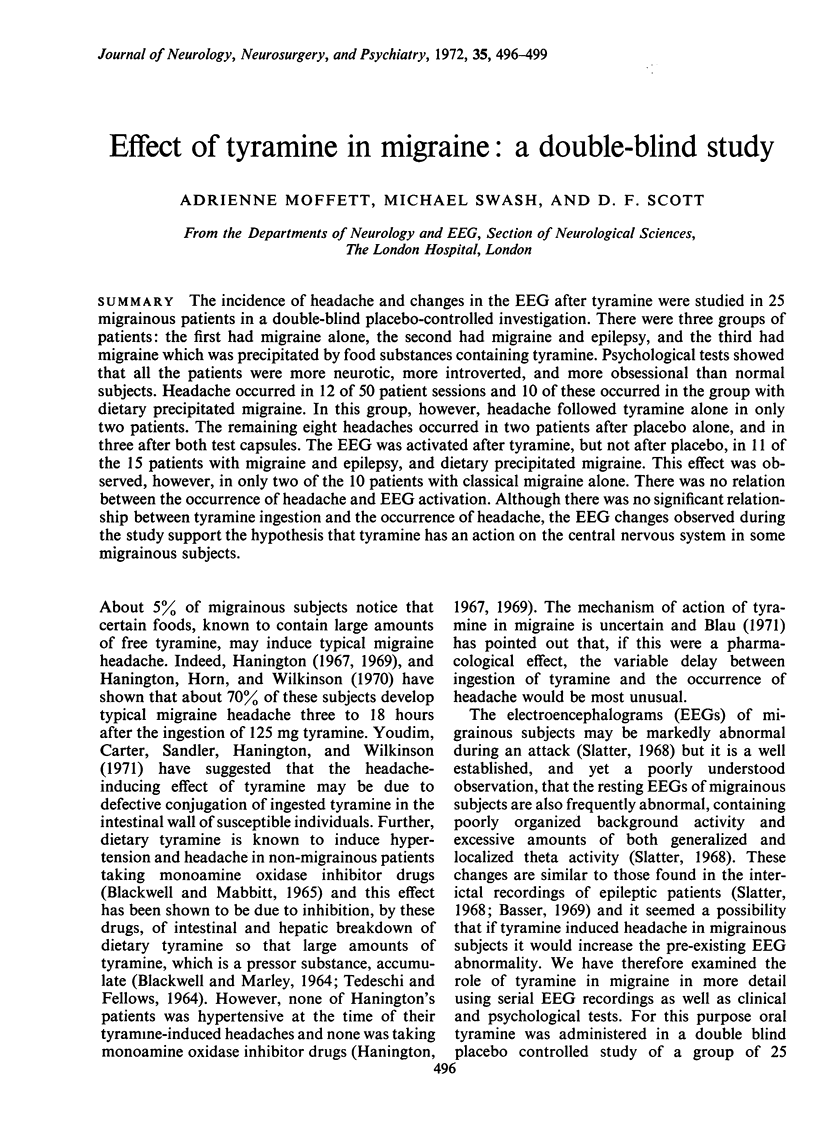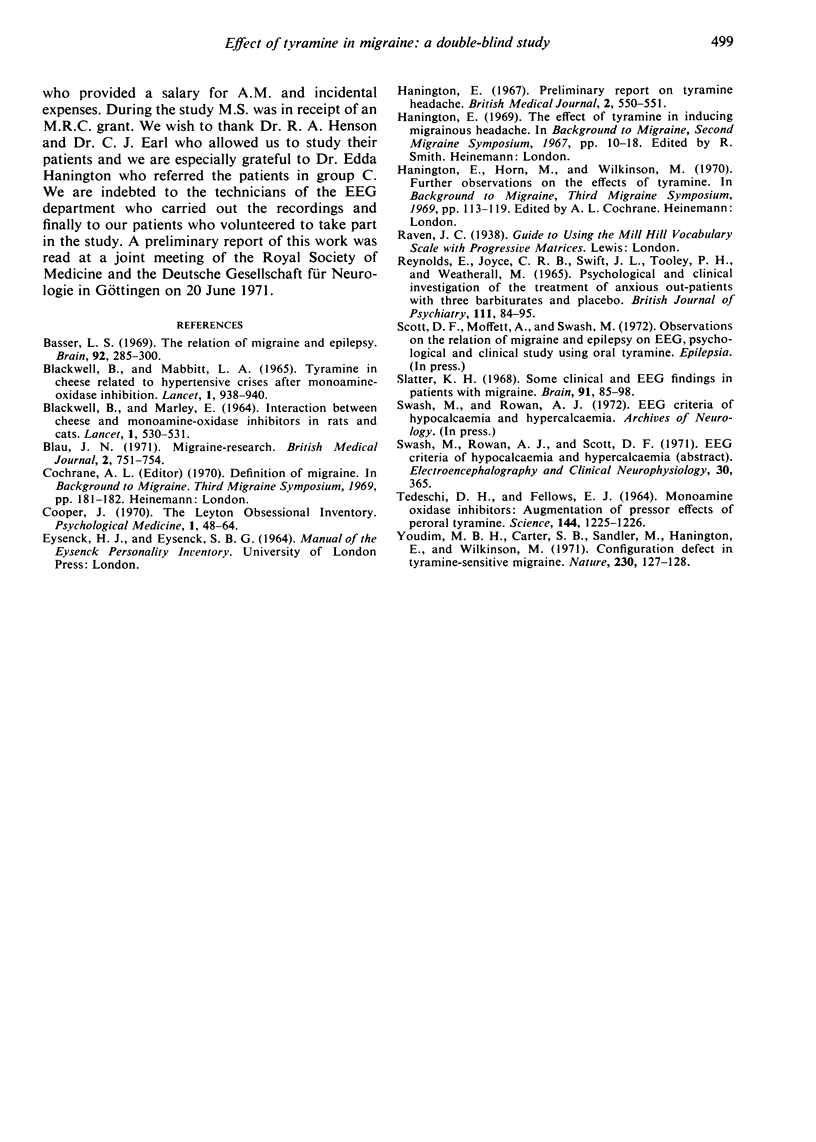Abstract
The incidence of headache and changes in the EEG after tyramine were studied in 25 migrainous patients in a double-blind placebo-controlled investigation. There were three groups of patients: the first had migraine alone, the second had migraine and epilepsy, and the third had migraine which was precipitated by food substances containing tyramine. Psychological tests showed that all the patients were more neurotic, more introverted, and more obsessional than normal subjects. Headache occurred in 12 of 50 patient sessions and 10 of these occurred in the group with dietary precipitated migraine. In this group, however, headache followed tyramine alone in only two patients. The remaining eight headaches occurred in two patients after placebo alone, and in three after both test capsules. The EEG was activated after tyramine, but not after placebo, in 11 of the 15 patients with migraine and epilepsy, and dietary precipitated migraine. This effect was observed, however, in only two of the 10 patients with classical migraine alone. There was no relation between the occurrence of headache and EEG activation. Although there was no significant relationship between tyramine ingestion and the occurrence of headache, the EEG changes observed during the study support the hypothesis that tyramine has an action on the central nervous system in some migrainous subjects.
Full text
PDF



Selected References
These references are in PubMed. This may not be the complete list of references from this article.
- BLACKWELL B., MABBITT L. A. TYRAMINE IN CHEESE RELATED TO HYPERTENSIVE CRISES AFTER MONOAMINE-OXIDASE INHIBITION. Lancet. 1965 May 1;1(7392):938–940. doi: 10.1016/s0140-6736(65)91257-2. [DOI] [PubMed] [Google Scholar]
- BLACKWELL B., MARLEY E. INTERACTION BETWEEN CHEESE AND MONOAMINE-OXIDASE INHIBITORS IN RATS AND CATS. Lancet. 1964 Mar 7;1(7332):530–531. doi: 10.1016/s0140-6736(64)92914-9. [DOI] [PubMed] [Google Scholar]
- Basser L. S. The relation of migraine and epilepsy. Brain. 1969;92(2):285–300. doi: 10.1093/brain/92.2.285. [DOI] [PubMed] [Google Scholar]
- Blau J. N. Migraine--research. Br Med J. 1971 Jun 26;2(5764):751–754. doi: 10.1136/bmj.2.5764.751. [DOI] [PMC free article] [PubMed] [Google Scholar]
- Cooper J. The Leyton obsessional inventory. Psychol Med. 1970 Nov;1(1):48–64. doi: 10.1017/s0033291700040010. [DOI] [PubMed] [Google Scholar]
- Hannington E. Preliminary report on tyramine headache. Br Med J. 1967 May 27;2(5551):550–551. doi: 10.1136/bmj.2.5551.550. [DOI] [PMC free article] [PubMed] [Google Scholar]
- REYNOLDS E., JOYCE C. R., SWIFT J. L., TOOLEY P. H., WEATHERALL M. PSYCHOLOGICAL AND CLINICAL INVESTIGATION OF THE TREATMENT OF ANXIOUS OUT-PATIENT WITH THREE BARBITURATES AND PLACEBO. Br J Psychiatry. 1965 Jan;111:84–95. doi: 10.1192/bjp.111.470.84. [DOI] [PubMed] [Google Scholar]
- Slatter K. H. Some clinical and EEG findings in patients with migraine. Brain. 1968 Mar;91(1):85–98. doi: 10.1093/brain/91.1.85. [DOI] [PubMed] [Google Scholar]
- Swash M., Rowan A. J., Scott D. F. EEG criteria of hypocalcaemia and hypercalcaemia. Electroencephalogr Clin Neurophysiol. 1971 Apr;30(4):365–365. [PubMed] [Google Scholar]
- TEDESCHI D. H., FELLOWS E. J. MONOAMINE OXIDASE INHIBITORS: AUGMENTATION OF PRESSOR EFFECTS OF PERORAL TYRAMINE. Science. 1964 Jun 5;144(3623):1225–1226. doi: 10.1126/science.144.3623.1225. [DOI] [PubMed] [Google Scholar]
- Youdim M. B., Carter S. B., Hanington E., Wilkinson M., Sandler M. Conjugation defect in tyramine-sensitive migraine. Nature. 1971 Mar 12;230(5289):127–128. doi: 10.1038/230127a0. [DOI] [PubMed] [Google Scholar]


